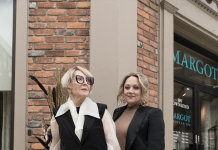 An act of rage is seldom productive. But in Kim Lowande’s case, it had a salutary, cathartic outcome.
An act of rage is seldom productive. But in Kim Lowande’s case, it had a salutary, cathartic outcome.
In 2007, at age 32, Lowande learned that her Stage 2B breast cancer had advanced to Stage 4, and the cancer had spread to her liver and bones.
Understandably, she was angry. So she began smashing tiles to smithereens.
This wasn’t a random act of violence. Doing so was part of making a collective mosaic during her art-therapy class at McLaren Macomb’s Ted B. Wahby Cancer Center in Mount Clemens. Others in the program tended to other details on the project, but Lowande, of Eastpointe, was the designated smash artist.
“I was in charge of breaking up tiles because I did it so well,” recalls Lowande, who still has cancer. “I was able to get rid of some of that anger and frustration. And yet, even though it looked like I was destroying something, when it was all done, it turned out to be a beautiful piece of artwork — not just by me but by all of us.”
Today that mosaic is on display at the cancer center.
Directing that class was art therapist Molly Murphy, who helped create McLaren Macomb’s healing arts program. Murphy, who’s also an artist, is still at McLaren, but also works in private practice and at schools. The Rochester resident engages with a wide range of clients — both in groups and individually — including children with disabilities and seniors with dementia. It doesn’t matter if her clients have autism, psychological disorders, or are physically challenged; as an art therapist she’s there to gently guide them into exploring their creative side.
“Conceptually, what I do is make creative space between me and another person or group, and provide the means, like a third hand, to have them do something creative,” Murphy says. “With art therapy, we address the physical, mental, emotional, and even the spiritual aspects of being human.”
The term “art therapy” didn’t emerge until the early 1940s, but the value of making art by those with physical and emotional disorders has been known for years. Zelda Fitzgerald, the mentally troubled wife of novelist F. Scott Fitzgerald, created some of her best work while she was in asylums from 1930 until her death in 1948. One of her creations from that time, a vibrant oil painting of nasturtiums that she gave to her psychiatrist at Johns Hopkins Hospital, was appraised in 2012 on Antiques Roadshow.
Most art created in a therapeutic setting may never reach such an audience, but that’s not the point. Neither is the ability to paint like Whistler or Sargent, though Murphy says many are reluctant initially because they don’t see themselves as artists. It isn’t important what participants create, she says. It’s that they create, which often leads to stress reduction and emotional well-being.
Lowande says she never saw herself as a creative person and was resistant to the idea that she could make anything.
“I had some trepidation at first, but Molly showed me that I do have a creative side,” she says. “When you go through cancer, there are some things you cannot put into words. So you use that creative outlet to express how you feel, and it’s amazing how better you feel after you do it. It’s like a weight that’s been lifted off your shoulders.”
The benefits aren’t just emotional, Murphy says. There are also physical advantages to art therapy.
“Doctors realize that part of treating a patient is also treating their stress and anxiety levels,” she says. “When you help them to reduce that stress and anxiety, it helps the medicine to work better, so their body isn’t actually fighting the medicine that’s trying to help them.”
Murphy says being an effective art therapist requires that one be compassionate, uncritical, and nonjudgmental. She says she doesn’t force anyone to make anything.
However, she’s noticed there’s often a snowball effect when others see someone take the artistic plunge.
“It can open doors,” she says. “They might see one person making something, then they’ll want to join in.”
Art therapy isn’t a one-size-fits-all treatment. Each patient or client is in a unique situation, and it’s Murphy’ task to understand that person’s position and nurture him or her.
She uses the autism spectrum as an example of the necessity to be sensitive to different needs.
“There are some autistic children who are tactile defensive,” she says, “and that means there are certain materials they don’t want to touch, that they find icky or gross and want to stay away from. So you avoid those things and find another activity that they like.
“But there are many autistic children who are highly visual and organized, and that’s one of the best ways they can communicate with the outside world.”
Murphy also says a particular medium might be more suitable than another, depending on that person’s emotional state. A collage will work for one person, painting for someone else, and pencil drawing for yet another.
“Different media will elicit a different response, and over time you can see different preferences for materials,” she says. “You can control Sharpies or pencils, so they’re good for people who need control in their life, say a child whose parents are going through a divorce.
“They need material they can manipulate and have control over. You wouldn’t give them finger painting to do.”
Art therapy is both art and science, and art therapists are versed in both. “You typically have to have a certain number of studio art hours and also a degree in psychology,” Murphy says. “You also have to go to grad school; there are no undergrad programs for it.”
Murphy got her degree from Wayne State University in 2000. She says an art therapist needn’t be a professional artist, although she manages to juggle both disciplines. And as the art-therapy movement gains steam, Murphy has noticed that a growing number of hospitals are adding healing arts programs.
For Lowande, the benefits of having participated in art therapy have endured to this day, even though she’s no longer in the program. A painting she made at McLaren proudly hangs in her dining room.
“I never did a painting before,” she explains. “But I used colors that make me happy — pinks and greens — and I created a floral scene.
“It just makes me feel good every time I see it.”
To contact Molly Murphy, call 248-470-2063.
|
|
|









